Stakeholder Analysis Report: Health Promotion for Aboriginal Cancer
VerifiedAdded on 2022/09/06
|12
|2213
|18
Report
AI Summary
This report presents a stakeholder analysis concerning the health of Aboriginal Australians, specifically addressing the issue of cancer. The analysis begins with an introduction to stakeholder analysis and its importance in understanding the impact of various groups on community health outcomes. The report then analyzes the target population, detailing the health status of Aboriginal communities, including the prevalence of cancer, respiratory issues, heart diseases, and diabetes, and the influence of socio-economic factors, demography, and social, behavioral, and environmental determinants. The analysis of services examines geographical disparities, workforce availability, and the effectiveness of government initiatives. The stakeholder analysis section identifies key stakeholders like the Australian Institute of Health and Welfare, the Aboriginal community, and businesses, outlining their involvement, interests, influence, and impact on the issue. The report concludes with recommendations for specific actions, such as promoting education, employment, and awareness programs, and stresses the importance of a multi-faceted approach involving government, community, and other stakeholders to improve health outcomes for Aboriginal Australians. The report references various academic sources to support its findings and recommendations.

HEALTH PROMOTION
Paraphrase This Document
Need a fresh take? Get an instant paraphrase of this document with our AI Paraphraser
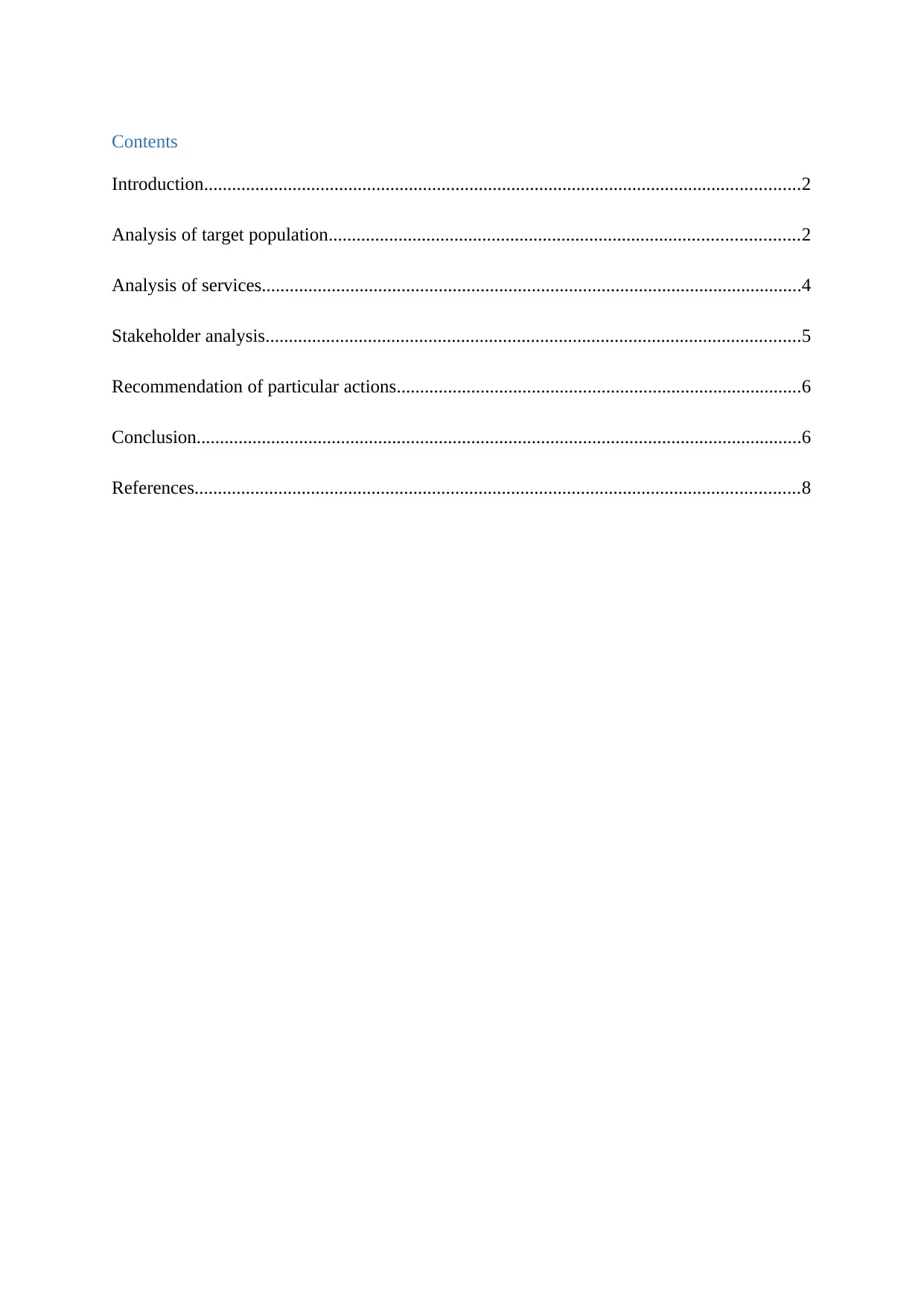
Contents
Introduction................................................................................................................................2
Analysis of target population.....................................................................................................2
Analysis of services....................................................................................................................4
Stakeholder analysis...................................................................................................................5
Recommendation of particular actions.......................................................................................6
Conclusion..................................................................................................................................6
References..................................................................................................................................8
Introduction................................................................................................................................2
Analysis of target population.....................................................................................................2
Analysis of services....................................................................................................................4
Stakeholder analysis...................................................................................................................5
Recommendation of particular actions.......................................................................................6
Conclusion..................................................................................................................................6
References..................................................................................................................................8
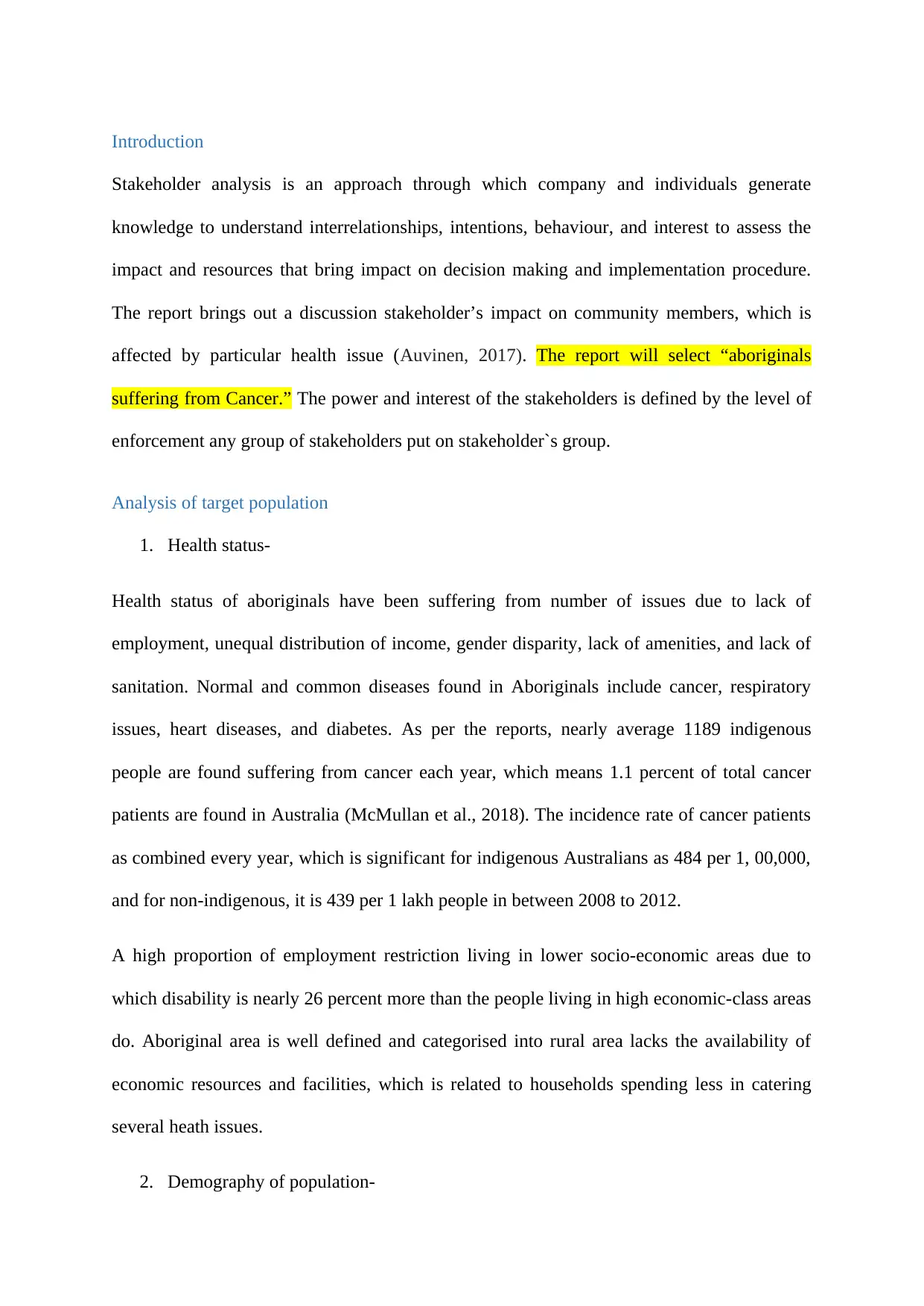
Introduction
Stakeholder analysis is an approach through which company and individuals generate
knowledge to understand interrelationships, intentions, behaviour, and interest to assess the
impact and resources that bring impact on decision making and implementation procedure.
The report brings out a discussion stakeholder’s impact on community members, which is
affected by particular health issue (Auvinen, 2017). The report will select “aboriginals
suffering from Cancer.” The power and interest of the stakeholders is defined by the level of
enforcement any group of stakeholders put on stakeholder`s group.
Analysis of target population
1. Health status-
Health status of aboriginals have been suffering from number of issues due to lack of
employment, unequal distribution of income, gender disparity, lack of amenities, and lack of
sanitation. Normal and common diseases found in Aboriginals include cancer, respiratory
issues, heart diseases, and diabetes. As per the reports, nearly average 1189 indigenous
people are found suffering from cancer each year, which means 1.1 percent of total cancer
patients are found in Australia (McMullan et al., 2018). The incidence rate of cancer patients
as combined every year, which is significant for indigenous Australians as 484 per 1, 00,000,
and for non-indigenous, it is 439 per 1 lakh people in between 2008 to 2012.
A high proportion of employment restriction living in lower socio-economic areas due to
which disability is nearly 26 percent more than the people living in high economic-class areas
do. Aboriginal area is well defined and categorised into rural area lacks the availability of
economic resources and facilities, which is related to households spending less in catering
several heath issues.
2. Demography of population-
Stakeholder analysis is an approach through which company and individuals generate
knowledge to understand interrelationships, intentions, behaviour, and interest to assess the
impact and resources that bring impact on decision making and implementation procedure.
The report brings out a discussion stakeholder’s impact on community members, which is
affected by particular health issue (Auvinen, 2017). The report will select “aboriginals
suffering from Cancer.” The power and interest of the stakeholders is defined by the level of
enforcement any group of stakeholders put on stakeholder`s group.
Analysis of target population
1. Health status-
Health status of aboriginals have been suffering from number of issues due to lack of
employment, unequal distribution of income, gender disparity, lack of amenities, and lack of
sanitation. Normal and common diseases found in Aboriginals include cancer, respiratory
issues, heart diseases, and diabetes. As per the reports, nearly average 1189 indigenous
people are found suffering from cancer each year, which means 1.1 percent of total cancer
patients are found in Australia (McMullan et al., 2018). The incidence rate of cancer patients
as combined every year, which is significant for indigenous Australians as 484 per 1, 00,000,
and for non-indigenous, it is 439 per 1 lakh people in between 2008 to 2012.
A high proportion of employment restriction living in lower socio-economic areas due to
which disability is nearly 26 percent more than the people living in high economic-class areas
do. Aboriginal area is well defined and categorised into rural area lacks the availability of
economic resources and facilities, which is related to households spending less in catering
several heath issues.
2. Demography of population-
⊘ This is a preview!⊘
Do you want full access?
Subscribe today to unlock all pages.

Trusted by 1+ million students worldwide
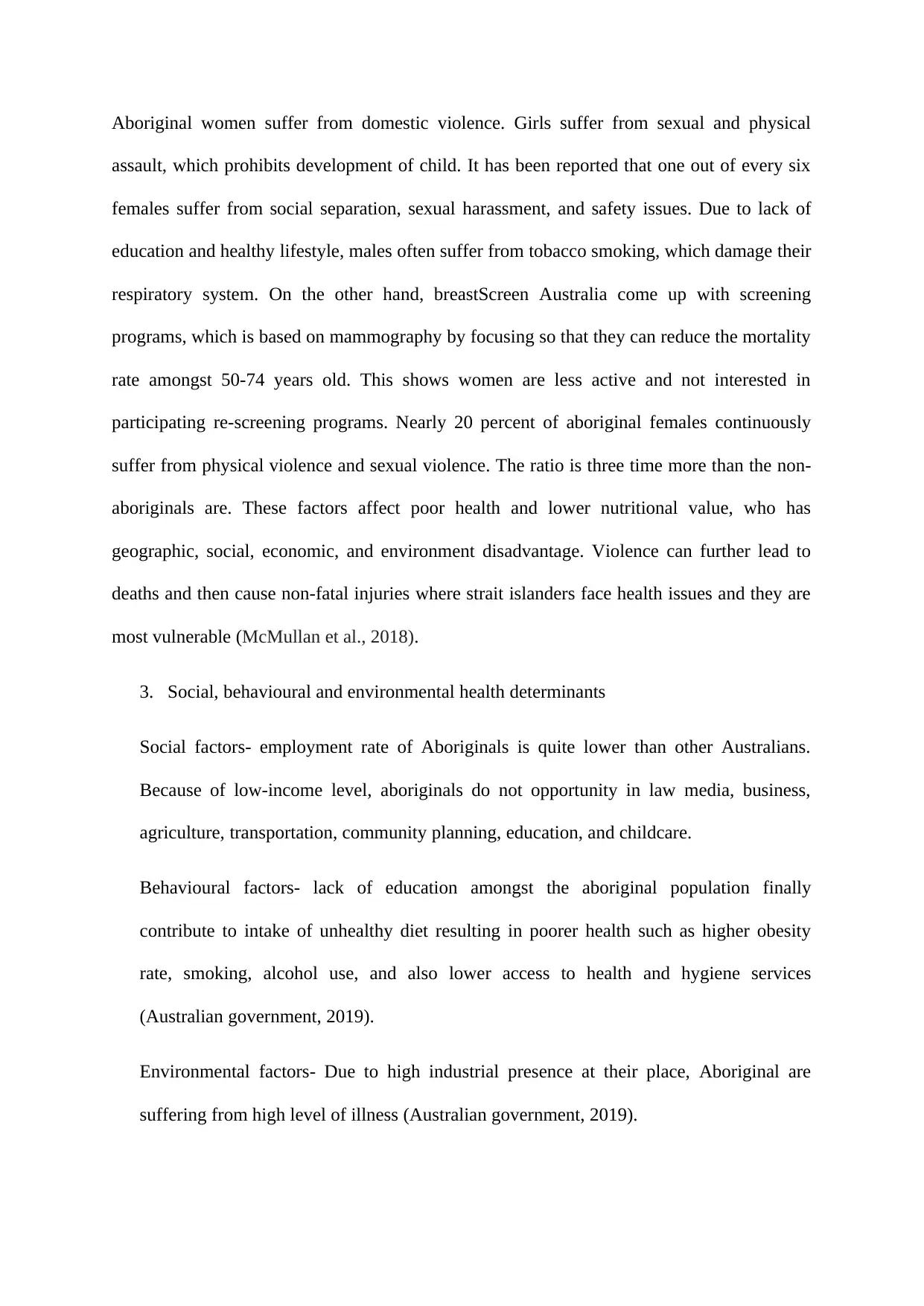
Aboriginal women suffer from domestic violence. Girls suffer from sexual and physical
assault, which prohibits development of child. It has been reported that one out of every six
females suffer from social separation, sexual harassment, and safety issues. Due to lack of
education and healthy lifestyle, males often suffer from tobacco smoking, which damage their
respiratory system. On the other hand, breastScreen Australia come up with screening
programs, which is based on mammography by focusing so that they can reduce the mortality
rate amongst 50-74 years old. This shows women are less active and not interested in
participating re-screening programs. Nearly 20 percent of aboriginal females continuously
suffer from physical violence and sexual violence. The ratio is three time more than the non-
aboriginals are. These factors affect poor health and lower nutritional value, who has
geographic, social, economic, and environment disadvantage. Violence can further lead to
deaths and then cause non-fatal injuries where strait islanders face health issues and they are
most vulnerable (McMullan et al., 2018).
3. Social, behavioural and environmental health determinants
Social factors- employment rate of Aboriginals is quite lower than other Australians.
Because of low-income level, aboriginals do not opportunity in law media, business,
agriculture, transportation, community planning, education, and childcare.
Behavioural factors- lack of education amongst the aboriginal population finally
contribute to intake of unhealthy diet resulting in poorer health such as higher obesity
rate, smoking, alcohol use, and also lower access to health and hygiene services
(Australian government, 2019).
Environmental factors- Due to high industrial presence at their place, Aboriginal are
suffering from high level of illness (Australian government, 2019).
assault, which prohibits development of child. It has been reported that one out of every six
females suffer from social separation, sexual harassment, and safety issues. Due to lack of
education and healthy lifestyle, males often suffer from tobacco smoking, which damage their
respiratory system. On the other hand, breastScreen Australia come up with screening
programs, which is based on mammography by focusing so that they can reduce the mortality
rate amongst 50-74 years old. This shows women are less active and not interested in
participating re-screening programs. Nearly 20 percent of aboriginal females continuously
suffer from physical violence and sexual violence. The ratio is three time more than the non-
aboriginals are. These factors affect poor health and lower nutritional value, who has
geographic, social, economic, and environment disadvantage. Violence can further lead to
deaths and then cause non-fatal injuries where strait islanders face health issues and they are
most vulnerable (McMullan et al., 2018).
3. Social, behavioural and environmental health determinants
Social factors- employment rate of Aboriginals is quite lower than other Australians.
Because of low-income level, aboriginals do not opportunity in law media, business,
agriculture, transportation, community planning, education, and childcare.
Behavioural factors- lack of education amongst the aboriginal population finally
contribute to intake of unhealthy diet resulting in poorer health such as higher obesity
rate, smoking, alcohol use, and also lower access to health and hygiene services
(Australian government, 2019).
Environmental factors- Due to high industrial presence at their place, Aboriginal are
suffering from high level of illness (Australian government, 2019).
Paraphrase This Document
Need a fresh take? Get an instant paraphrase of this document with our AI Paraphraser
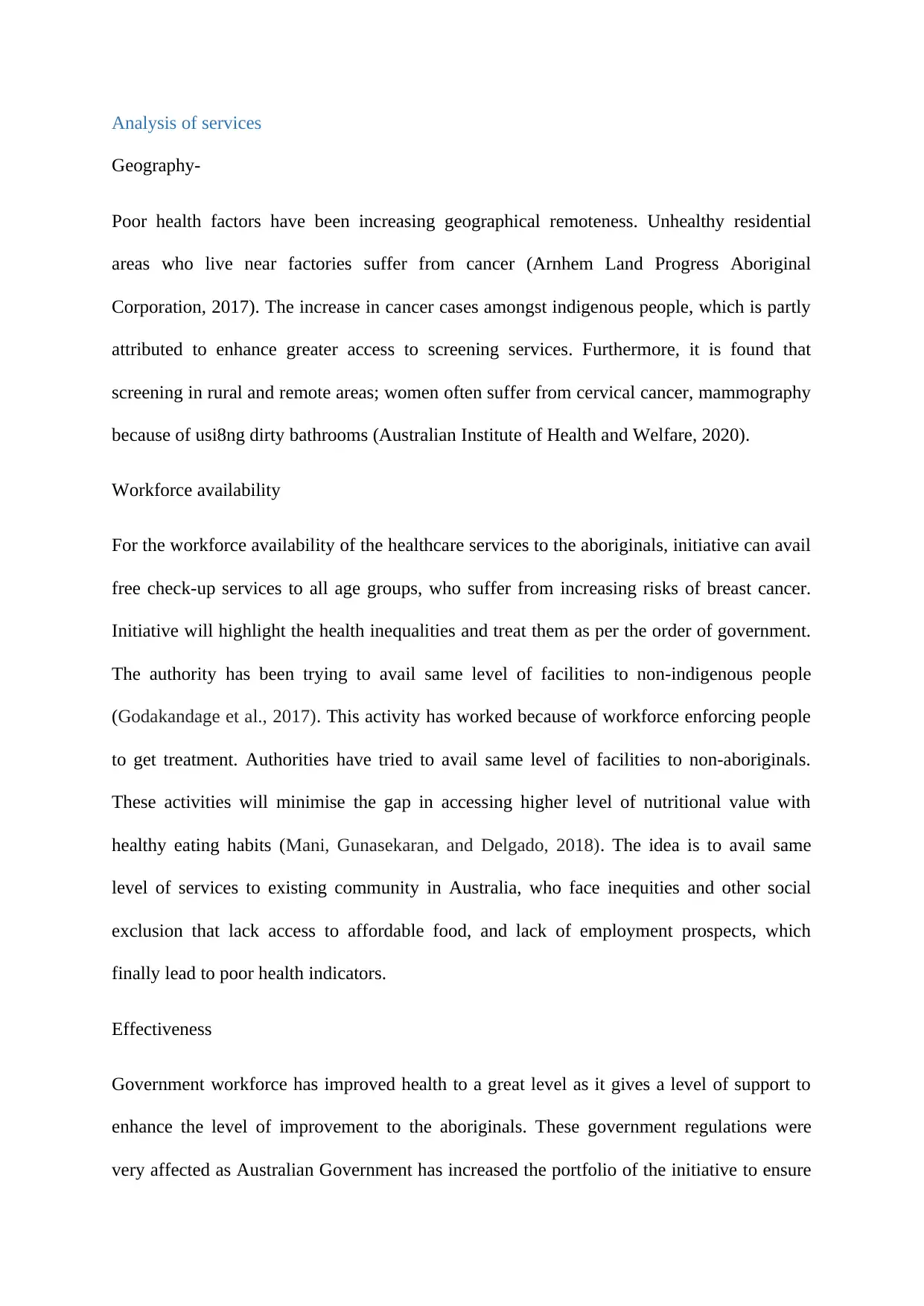
Analysis of services
Geography-
Poor health factors have been increasing geographical remoteness. Unhealthy residential
areas who live near factories suffer from cancer (Arnhem Land Progress Aboriginal
Corporation, 2017). The increase in cancer cases amongst indigenous people, which is partly
attributed to enhance greater access to screening services. Furthermore, it is found that
screening in rural and remote areas; women often suffer from cervical cancer, mammography
because of usi8ng dirty bathrooms (Australian Institute of Health and Welfare, 2020).
Workforce availability
For the workforce availability of the healthcare services to the aboriginals, initiative can avail
free check-up services to all age groups, who suffer from increasing risks of breast cancer.
Initiative will highlight the health inequalities and treat them as per the order of government.
The authority has been trying to avail same level of facilities to non-indigenous people
(Godakandage et al., 2017). This activity has worked because of workforce enforcing people
to get treatment. Authorities have tried to avail same level of facilities to non-aboriginals.
These activities will minimise the gap in accessing higher level of nutritional value with
healthy eating habits (Mani, Gunasekaran, and Delgado, 2018). The idea is to avail same
level of services to existing community in Australia, who face inequities and other social
exclusion that lack access to affordable food, and lack of employment prospects, which
finally lead to poor health indicators.
Effectiveness
Government workforce has improved health to a great level as it gives a level of support to
enhance the level of improvement to the aboriginals. These government regulations were
very affected as Australian Government has increased the portfolio of the initiative to ensure
Geography-
Poor health factors have been increasing geographical remoteness. Unhealthy residential
areas who live near factories suffer from cancer (Arnhem Land Progress Aboriginal
Corporation, 2017). The increase in cancer cases amongst indigenous people, which is partly
attributed to enhance greater access to screening services. Furthermore, it is found that
screening in rural and remote areas; women often suffer from cervical cancer, mammography
because of usi8ng dirty bathrooms (Australian Institute of Health and Welfare, 2020).
Workforce availability
For the workforce availability of the healthcare services to the aboriginals, initiative can avail
free check-up services to all age groups, who suffer from increasing risks of breast cancer.
Initiative will highlight the health inequalities and treat them as per the order of government.
The authority has been trying to avail same level of facilities to non-indigenous people
(Godakandage et al., 2017). This activity has worked because of workforce enforcing people
to get treatment. Authorities have tried to avail same level of facilities to non-aboriginals.
These activities will minimise the gap in accessing higher level of nutritional value with
healthy eating habits (Mani, Gunasekaran, and Delgado, 2018). The idea is to avail same
level of services to existing community in Australia, who face inequities and other social
exclusion that lack access to affordable food, and lack of employment prospects, which
finally lead to poor health indicators.
Effectiveness
Government workforce has improved health to a great level as it gives a level of support to
enhance the level of improvement to the aboriginals. These government regulations were
very affected as Australian Government has increased the portfolio of the initiative to ensure
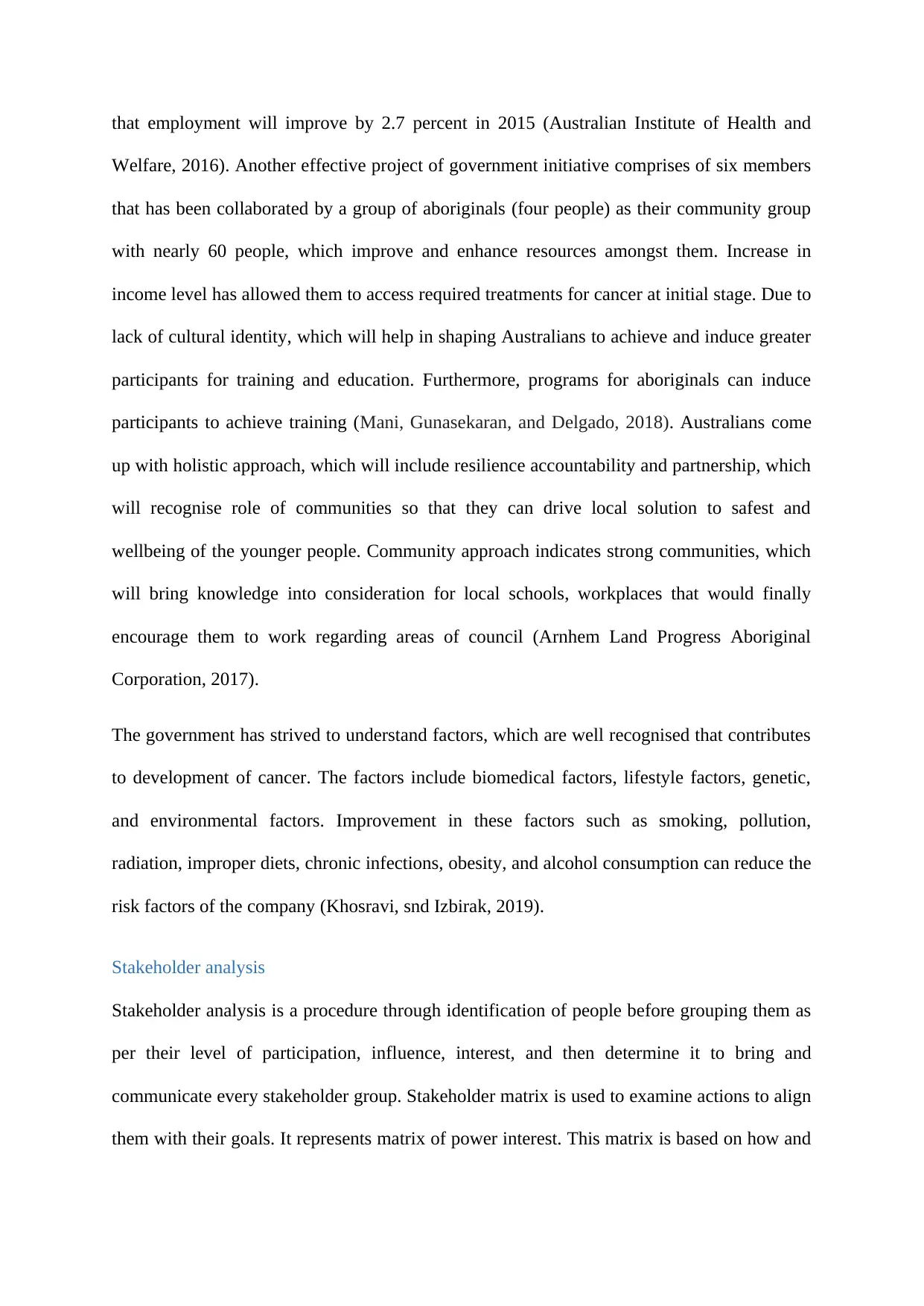
that employment will improve by 2.7 percent in 2015 (Australian Institute of Health and
Welfare, 2016). Another effective project of government initiative comprises of six members
that has been collaborated by a group of aboriginals (four people) as their community group
with nearly 60 people, which improve and enhance resources amongst them. Increase in
income level has allowed them to access required treatments for cancer at initial stage. Due to
lack of cultural identity, which will help in shaping Australians to achieve and induce greater
participants for training and education. Furthermore, programs for aboriginals can induce
participants to achieve training (Mani, Gunasekaran, and Delgado, 2018). Australians come
up with holistic approach, which will include resilience accountability and partnership, which
will recognise role of communities so that they can drive local solution to safest and
wellbeing of the younger people. Community approach indicates strong communities, which
will bring knowledge into consideration for local schools, workplaces that would finally
encourage them to work regarding areas of council (Arnhem Land Progress Aboriginal
Corporation, 2017).
The government has strived to understand factors, which are well recognised that contributes
to development of cancer. The factors include biomedical factors, lifestyle factors, genetic,
and environmental factors. Improvement in these factors such as smoking, pollution,
radiation, improper diets, chronic infections, obesity, and alcohol consumption can reduce the
risk factors of the company (Khosravi, snd Izbirak, 2019).
Stakeholder analysis
Stakeholder analysis is a procedure through identification of people before grouping them as
per their level of participation, influence, interest, and then determine it to bring and
communicate every stakeholder group. Stakeholder matrix is used to examine actions to align
them with their goals. It represents matrix of power interest. This matrix is based on how and
Welfare, 2016). Another effective project of government initiative comprises of six members
that has been collaborated by a group of aboriginals (four people) as their community group
with nearly 60 people, which improve and enhance resources amongst them. Increase in
income level has allowed them to access required treatments for cancer at initial stage. Due to
lack of cultural identity, which will help in shaping Australians to achieve and induce greater
participants for training and education. Furthermore, programs for aboriginals can induce
participants to achieve training (Mani, Gunasekaran, and Delgado, 2018). Australians come
up with holistic approach, which will include resilience accountability and partnership, which
will recognise role of communities so that they can drive local solution to safest and
wellbeing of the younger people. Community approach indicates strong communities, which
will bring knowledge into consideration for local schools, workplaces that would finally
encourage them to work regarding areas of council (Arnhem Land Progress Aboriginal
Corporation, 2017).
The government has strived to understand factors, which are well recognised that contributes
to development of cancer. The factors include biomedical factors, lifestyle factors, genetic,
and environmental factors. Improvement in these factors such as smoking, pollution,
radiation, improper diets, chronic infections, obesity, and alcohol consumption can reduce the
risk factors of the company (Khosravi, snd Izbirak, 2019).
Stakeholder analysis
Stakeholder analysis is a procedure through identification of people before grouping them as
per their level of participation, influence, interest, and then determine it to bring and
communicate every stakeholder group. Stakeholder matrix is used to examine actions to align
them with their goals. It represents matrix of power interest. This matrix is based on how and
⊘ This is a preview!⊘
Do you want full access?
Subscribe today to unlock all pages.

Trusted by 1+ million students worldwide
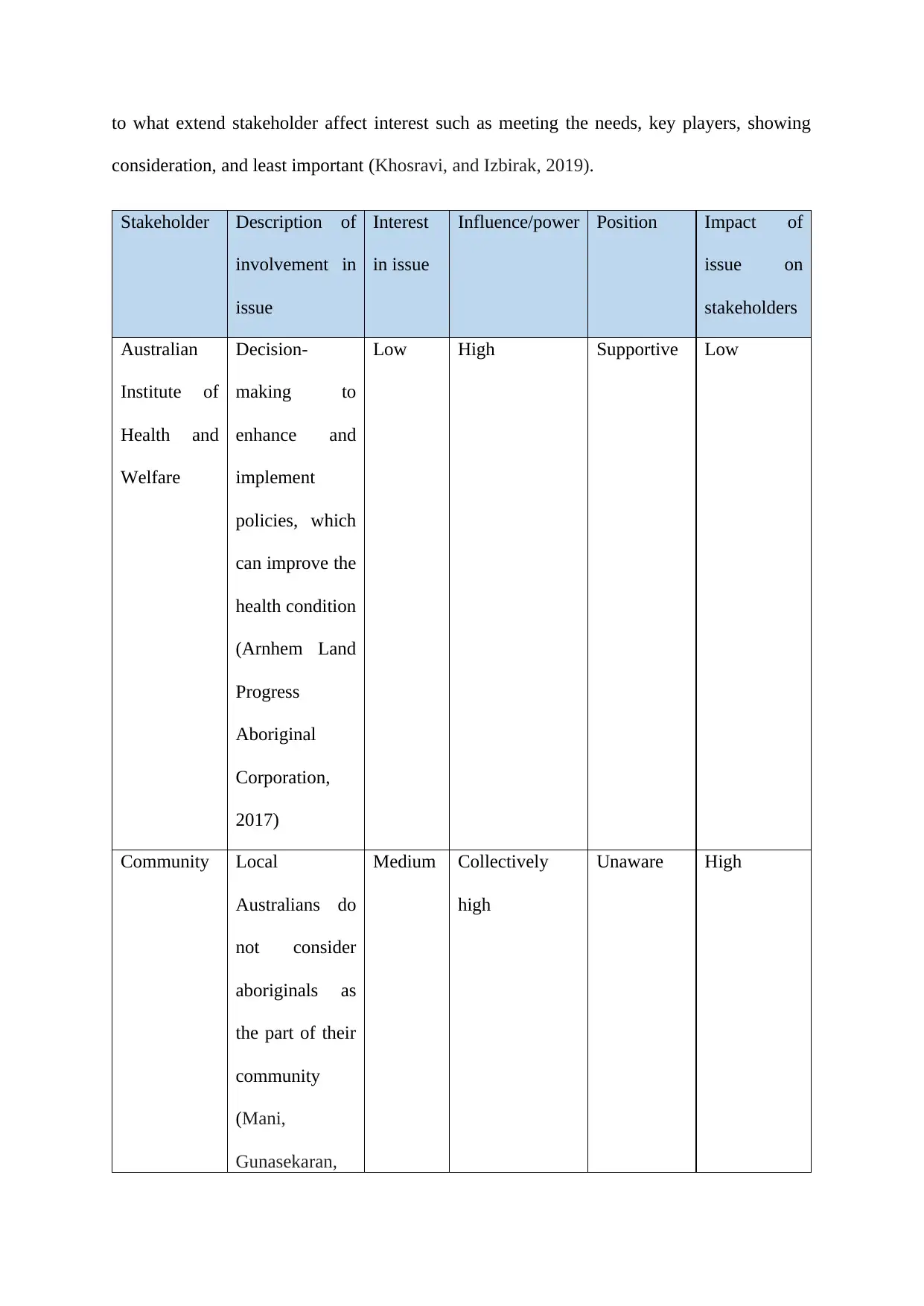
to what extend stakeholder affect interest such as meeting the needs, key players, showing
consideration, and least important (Khosravi, and Izbirak, 2019).
Stakeholder Description of
involvement in
issue
Interest
in issue
Influence/power Position Impact of
issue on
stakeholders
Australian
Institute of
Health and
Welfare
Decision-
making to
enhance and
implement
policies, which
can improve the
health condition
(Arnhem Land
Progress
Aboriginal
Corporation,
2017)
Low High Supportive Low
Community Local
Australians do
not consider
aboriginals as
the part of their
community
(Mani,
Gunasekaran,
Medium Collectively
high
Unaware High
consideration, and least important (Khosravi, and Izbirak, 2019).
Stakeholder Description of
involvement in
issue
Interest
in issue
Influence/power Position Impact of
issue on
stakeholders
Australian
Institute of
Health and
Welfare
Decision-
making to
enhance and
implement
policies, which
can improve the
health condition
(Arnhem Land
Progress
Aboriginal
Corporation,
2017)
Low High Supportive Low
Community Local
Australians do
not consider
aboriginals as
the part of their
community
(Mani,
Gunasekaran,
Medium Collectively
high
Unaware High
Paraphrase This Document
Need a fresh take? Get an instant paraphrase of this document with our AI Paraphraser
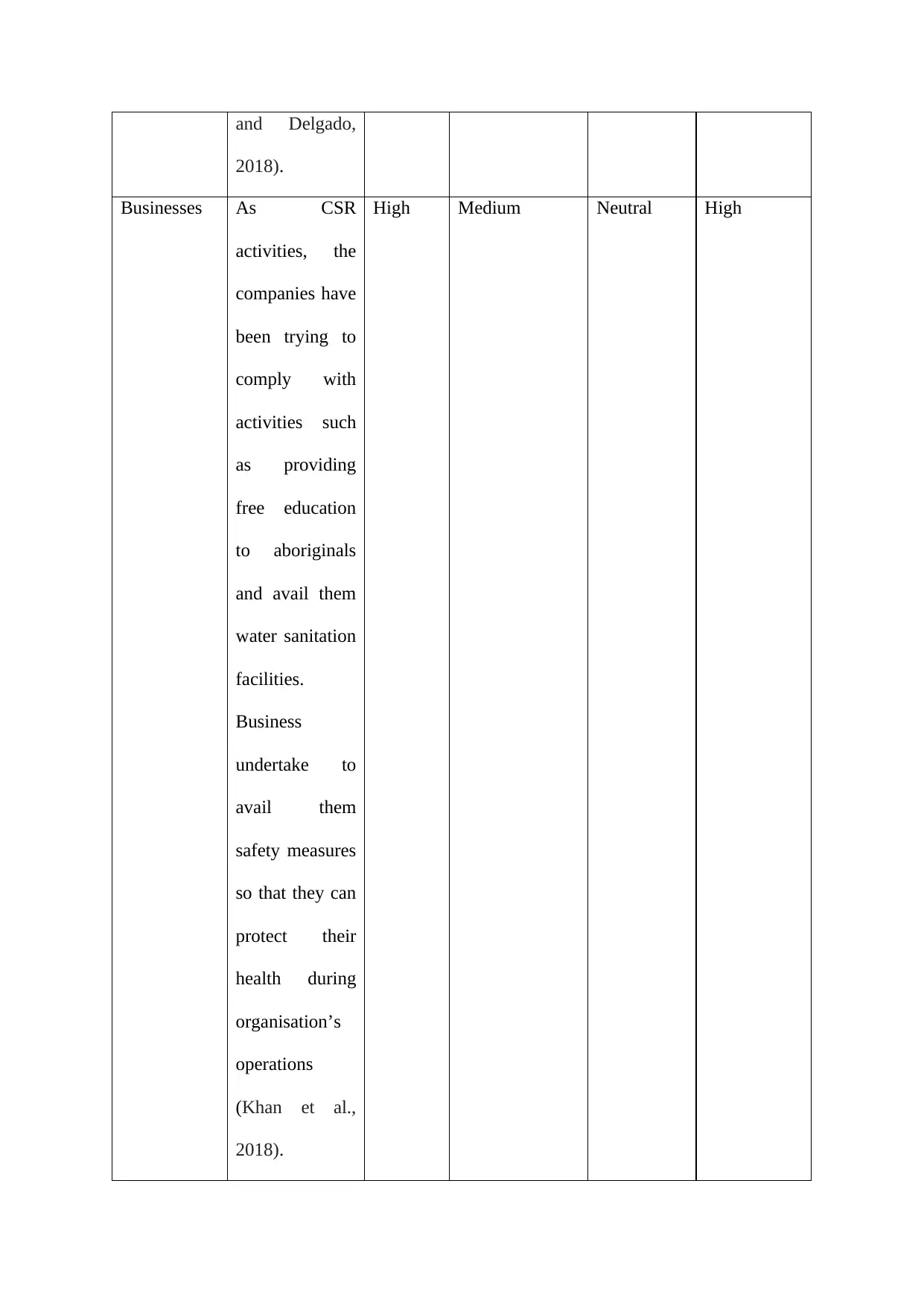
and Delgado,
2018).
Businesses As CSR
activities, the
companies have
been trying to
comply with
activities such
as providing
free education
to aboriginals
and avail them
water sanitation
facilities.
Business
undertake to
avail them
safety measures
so that they can
protect their
health during
organisation’s
operations
(Khan et al.,
2018).
High Medium Neutral High
2018).
Businesses As CSR
activities, the
companies have
been trying to
comply with
activities such
as providing
free education
to aboriginals
and avail them
water sanitation
facilities.
Business
undertake to
avail them
safety measures
so that they can
protect their
health during
organisation’s
operations
(Khan et al.,
2018).
High Medium Neutral High
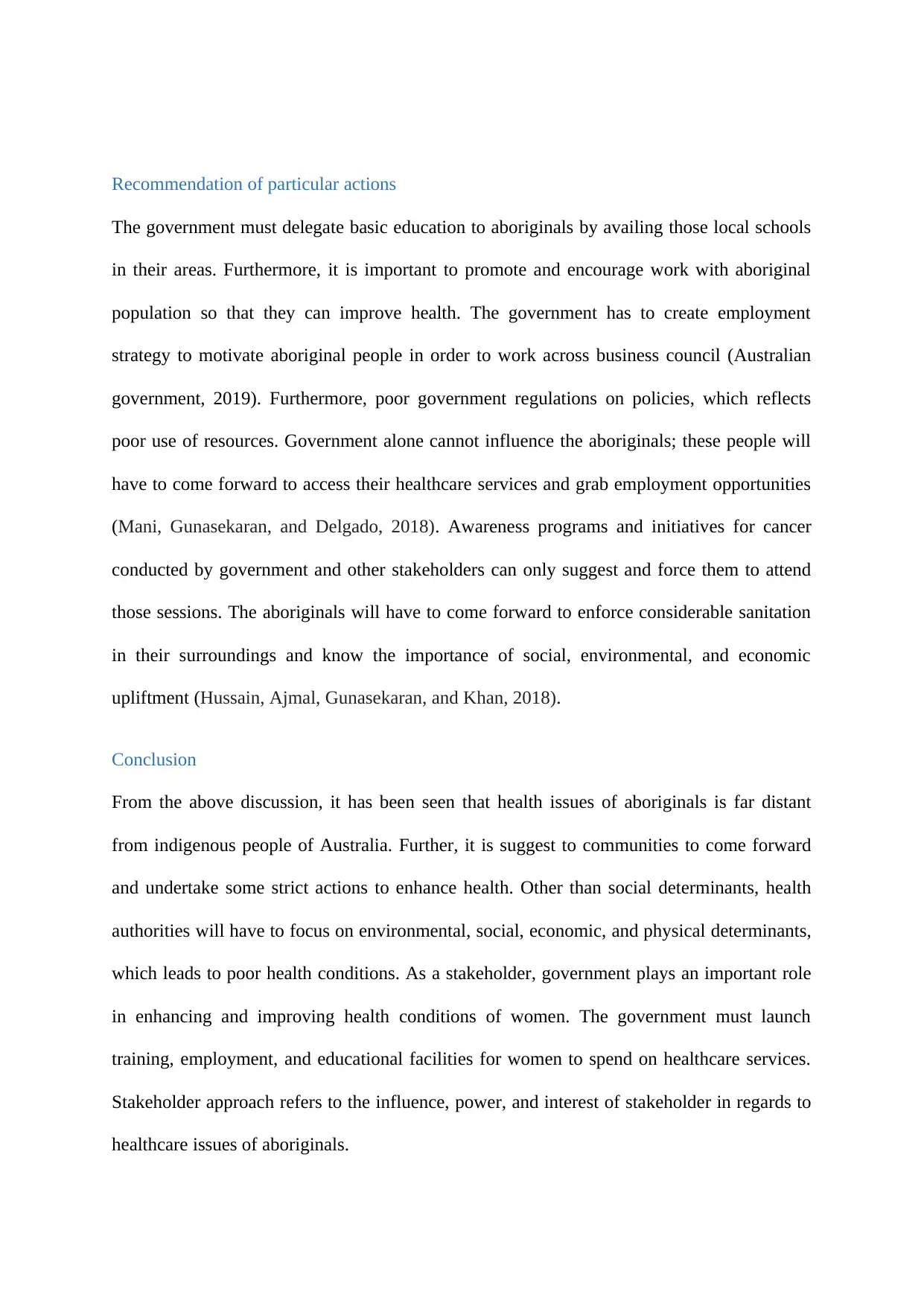
Recommendation of particular actions
The government must delegate basic education to aboriginals by availing those local schools
in their areas. Furthermore, it is important to promote and encourage work with aboriginal
population so that they can improve health. The government has to create employment
strategy to motivate aboriginal people in order to work across business council (Australian
government, 2019). Furthermore, poor government regulations on policies, which reflects
poor use of resources. Government alone cannot influence the aboriginals; these people will
have to come forward to access their healthcare services and grab employment opportunities
(Mani, Gunasekaran, and Delgado, 2018). Awareness programs and initiatives for cancer
conducted by government and other stakeholders can only suggest and force them to attend
those sessions. The aboriginals will have to come forward to enforce considerable sanitation
in their surroundings and know the importance of social, environmental, and economic
upliftment (Hussain, Ajmal, Gunasekaran, and Khan, 2018).
Conclusion
From the above discussion, it has been seen that health issues of aboriginals is far distant
from indigenous people of Australia. Further, it is suggest to communities to come forward
and undertake some strict actions to enhance health. Other than social determinants, health
authorities will have to focus on environmental, social, economic, and physical determinants,
which leads to poor health conditions. As a stakeholder, government plays an important role
in enhancing and improving health conditions of women. The government must launch
training, employment, and educational facilities for women to spend on healthcare services.
Stakeholder approach refers to the influence, power, and interest of stakeholder in regards to
healthcare issues of aboriginals.
The government must delegate basic education to aboriginals by availing those local schools
in their areas. Furthermore, it is important to promote and encourage work with aboriginal
population so that they can improve health. The government has to create employment
strategy to motivate aboriginal people in order to work across business council (Australian
government, 2019). Furthermore, poor government regulations on policies, which reflects
poor use of resources. Government alone cannot influence the aboriginals; these people will
have to come forward to access their healthcare services and grab employment opportunities
(Mani, Gunasekaran, and Delgado, 2018). Awareness programs and initiatives for cancer
conducted by government and other stakeholders can only suggest and force them to attend
those sessions. The aboriginals will have to come forward to enforce considerable sanitation
in their surroundings and know the importance of social, environmental, and economic
upliftment (Hussain, Ajmal, Gunasekaran, and Khan, 2018).
Conclusion
From the above discussion, it has been seen that health issues of aboriginals is far distant
from indigenous people of Australia. Further, it is suggest to communities to come forward
and undertake some strict actions to enhance health. Other than social determinants, health
authorities will have to focus on environmental, social, economic, and physical determinants,
which leads to poor health conditions. As a stakeholder, government plays an important role
in enhancing and improving health conditions of women. The government must launch
training, employment, and educational facilities for women to spend on healthcare services.
Stakeholder approach refers to the influence, power, and interest of stakeholder in regards to
healthcare issues of aboriginals.
⊘ This is a preview!⊘
Do you want full access?
Subscribe today to unlock all pages.

Trusted by 1+ million students worldwide

Paraphrase This Document
Need a fresh take? Get an instant paraphrase of this document with our AI Paraphraser
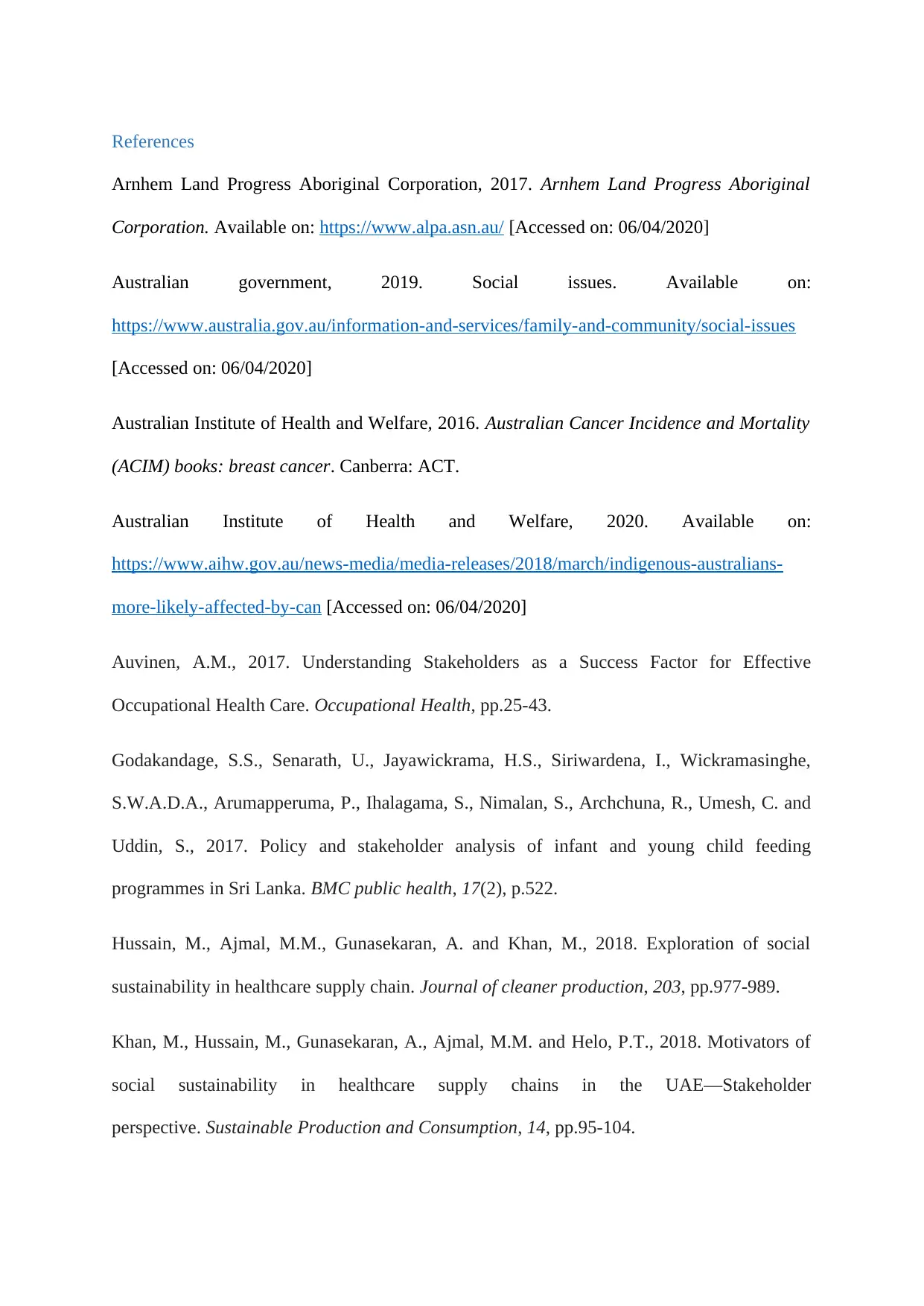
References
Arnhem Land Progress Aboriginal Corporation, 2017. Arnhem Land Progress Aboriginal
Corporation. Available on: https://www.alpa.asn.au/ [Accessed on: 06/04/2020]
Australian government, 2019. Social issues. Available on:
https://www.australia.gov.au/information-and-services/family-and-community/social-issues
[Accessed on: 06/04/2020]
Australian Institute of Health and Welfare, 2016. Australian Cancer Incidence and Mortality
(ACIM) books: breast cancer. Canberra: ACT.
Australian Institute of Health and Welfare, 2020. Available on:
https://www.aihw.gov.au/news-media/media-releases/2018/march/indigenous-australians-
more-likely-affected-by-can [Accessed on: 06/04/2020]
Auvinen, A.M., 2017. Understanding Stakeholders as a Success Factor for Effective
Occupational Health Care. Occupational Health, pp.25-43.
Godakandage, S.S., Senarath, U., Jayawickrama, H.S., Siriwardena, I., Wickramasinghe,
S.W.A.D.A., Arumapperuma, P., Ihalagama, S., Nimalan, S., Archchuna, R., Umesh, C. and
Uddin, S., 2017. Policy and stakeholder analysis of infant and young child feeding
programmes in Sri Lanka. BMC public health, 17(2), p.522.
Hussain, M., Ajmal, M.M., Gunasekaran, A. and Khan, M., 2018. Exploration of social
sustainability in healthcare supply chain. Journal of cleaner production, 203, pp.977-989.
Khan, M., Hussain, M., Gunasekaran, A., Ajmal, M.M. and Helo, P.T., 2018. Motivators of
social sustainability in healthcare supply chains in the UAE—Stakeholder
perspective. Sustainable Production and Consumption, 14, pp.95-104.
Arnhem Land Progress Aboriginal Corporation, 2017. Arnhem Land Progress Aboriginal
Corporation. Available on: https://www.alpa.asn.au/ [Accessed on: 06/04/2020]
Australian government, 2019. Social issues. Available on:
https://www.australia.gov.au/information-and-services/family-and-community/social-issues
[Accessed on: 06/04/2020]
Australian Institute of Health and Welfare, 2016. Australian Cancer Incidence and Mortality
(ACIM) books: breast cancer. Canberra: ACT.
Australian Institute of Health and Welfare, 2020. Available on:
https://www.aihw.gov.au/news-media/media-releases/2018/march/indigenous-australians-
more-likely-affected-by-can [Accessed on: 06/04/2020]
Auvinen, A.M., 2017. Understanding Stakeholders as a Success Factor for Effective
Occupational Health Care. Occupational Health, pp.25-43.
Godakandage, S.S., Senarath, U., Jayawickrama, H.S., Siriwardena, I., Wickramasinghe,
S.W.A.D.A., Arumapperuma, P., Ihalagama, S., Nimalan, S., Archchuna, R., Umesh, C. and
Uddin, S., 2017. Policy and stakeholder analysis of infant and young child feeding
programmes in Sri Lanka. BMC public health, 17(2), p.522.
Hussain, M., Ajmal, M.M., Gunasekaran, A. and Khan, M., 2018. Exploration of social
sustainability in healthcare supply chain. Journal of cleaner production, 203, pp.977-989.
Khan, M., Hussain, M., Gunasekaran, A., Ajmal, M.M. and Helo, P.T., 2018. Motivators of
social sustainability in healthcare supply chains in the UAE—Stakeholder
perspective. Sustainable Production and Consumption, 14, pp.95-104.
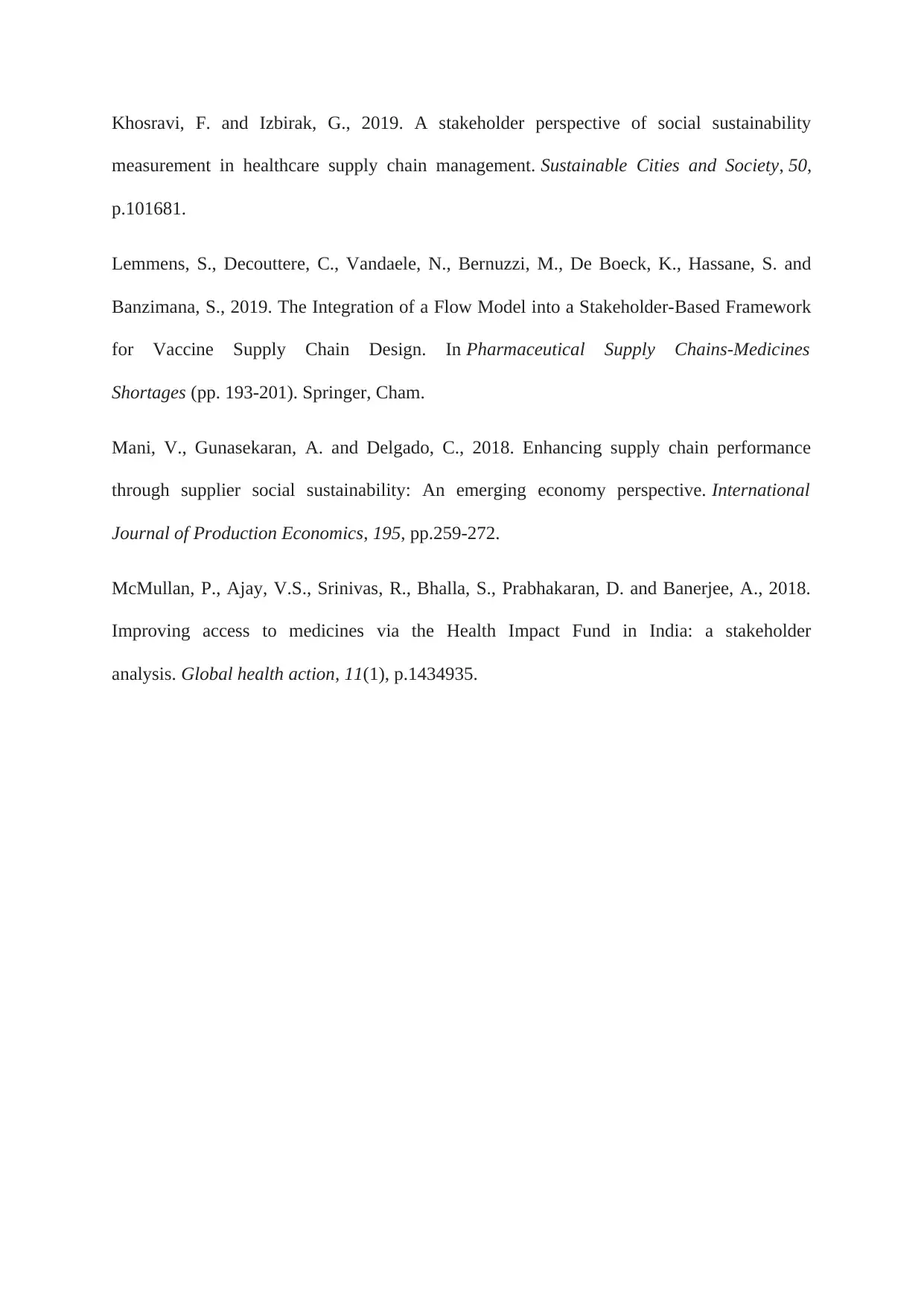
Khosravi, F. and Izbirak, G., 2019. A stakeholder perspective of social sustainability
measurement in healthcare supply chain management. Sustainable Cities and Society, 50,
p.101681.
Lemmens, S., Decouttere, C., Vandaele, N., Bernuzzi, M., De Boeck, K., Hassane, S. and
Banzimana, S., 2019. The Integration of a Flow Model into a Stakeholder-Based Framework
for Vaccine Supply Chain Design. In Pharmaceutical Supply Chains-Medicines
Shortages (pp. 193-201). Springer, Cham.
Mani, V., Gunasekaran, A. and Delgado, C., 2018. Enhancing supply chain performance
through supplier social sustainability: An emerging economy perspective. International
Journal of Production Economics, 195, pp.259-272.
McMullan, P., Ajay, V.S., Srinivas, R., Bhalla, S., Prabhakaran, D. and Banerjee, A., 2018.
Improving access to medicines via the Health Impact Fund in India: a stakeholder
analysis. Global health action, 11(1), p.1434935.
measurement in healthcare supply chain management. Sustainable Cities and Society, 50,
p.101681.
Lemmens, S., Decouttere, C., Vandaele, N., Bernuzzi, M., De Boeck, K., Hassane, S. and
Banzimana, S., 2019. The Integration of a Flow Model into a Stakeholder-Based Framework
for Vaccine Supply Chain Design. In Pharmaceutical Supply Chains-Medicines
Shortages (pp. 193-201). Springer, Cham.
Mani, V., Gunasekaran, A. and Delgado, C., 2018. Enhancing supply chain performance
through supplier social sustainability: An emerging economy perspective. International
Journal of Production Economics, 195, pp.259-272.
McMullan, P., Ajay, V.S., Srinivas, R., Bhalla, S., Prabhakaran, D. and Banerjee, A., 2018.
Improving access to medicines via the Health Impact Fund in India: a stakeholder
analysis. Global health action, 11(1), p.1434935.
⊘ This is a preview!⊘
Do you want full access?
Subscribe today to unlock all pages.

Trusted by 1+ million students worldwide
1 out of 12
Related Documents
Your All-in-One AI-Powered Toolkit for Academic Success.
+13062052269
info@desklib.com
Available 24*7 on WhatsApp / Email
![[object Object]](/_next/static/media/star-bottom.7253800d.svg)
Unlock your academic potential
Copyright © 2020–2025 A2Z Services. All Rights Reserved. Developed and managed by ZUCOL.





